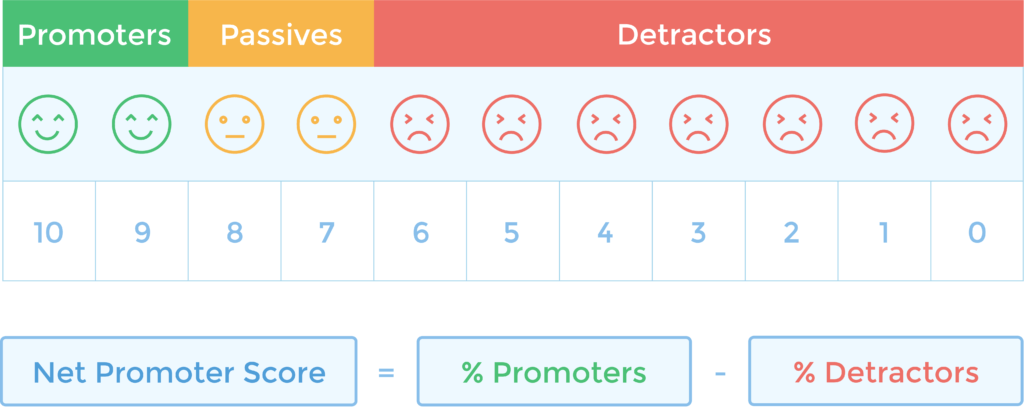16 essential customer service metrics you can’t do without
What do you make of this phrase: If we want to improve our CSAT then we need to increase FCR!

What do you make of this phrase: If we want to improve our CSAT then we need to increase FCR!

What do you make of this phrase: If we want to improve our CSAT then we need to increase FCR!
If you’re new to customer service then this is probably complete gibberish to you.
In some ways, getting started in the customer service industry is like traveling: If you don’t speak the language, you’re going to find the trip very confusing and you may end up getting lost.
As a reference, we’re listing the most important customer service metrics in this blog. Think of it as your personal travel dictionary to help you communicate with the locals.

Knowingly or not, you’ve probably already filled out a net promoter score survey at least once in your life. The net promoter score is calculated on an 11-point scale. Customers are asked the following question:
How likely are you to recommend our product/service to your family, friends, or colleagues?
Customers are asked to rate that likeliness on an 11-point scale from 0 to 10. Customers who answer between 0 and 6 are considered detractors. 7 to 8 are considered neutral, and 9 to 10 are considered brand promoters.

(source)
Bear in mind that while this metric is often measured after a customer service interaction, it isn’t technically a customer service metric. The net promoter score measures the overall satisfaction with a brand’s product/service and does not relate directly to the service experience.
Customer satisfaction, like NPS, measures a customer’s satisfaction with a specific part of the customer experience and can be tailored to the part of the experience you’d like to know more about. An example:
How satisfied are you with the technical setup of your new device?
The customer’s responses are scored on a 5-point likert scale with possible responses ranging between:
Very unsatisfied / unsatisfied / neutral / satisfied / very satisfied
The overall CSAT score is calculated by finding the percentage of customers who answered satisfied or very satisfied. CSAT is like the swiss army knife of customer service KPIs; It can be adapted to answer a whole range of questions from satisfaction with the product, with customer service, with onboarding, installation etc.
Sentiment analysis is used extensively in social media customer service. Most social media tools can automatically detect sentiments in posts, comments, tweets, etc.
In sentiment analysis, a ‘1’ is assigned to a positive comment, ‘0’ to a neutral comment, and ‘-1’ to a negative comment. Adding the scores up results in a single numerical value called ‘Net sentiment score’. The higher you score above zero, the better your net sentiment score.
Within most contact centers and larger customer service departments, Quality Assurance is its very own department. The quality assurance team listens to (or reads) a percentage of service interactions and scores those interactions as if they were grading an exam.
There is no universal measurement for QA since every company has unique ways in which it likes to interact with its customers, and the quality scoring needs to be adapted to those requirements.
In an outsourced environment, strict agreements are made between client and outsourcer about which elements of the customer interaction are most important. Some examples of scoring criteria:
1. The agent used the proper opening statement: Thanking the customer for calling, mentioning the brand name, and identifying themselves to the customer.
2. The agent avoided long silences throughout the call.
3. The technical information provided by the agent is correct.
4. All inquiries made by the customer were acknowledged by the agent
The customer effort score, other than CSAT, NPS, and QA, isn’t technically a quality measurement. Instead, it measures the amount of effort a customer has had to go through in order to resolve a case. Customer effort score is widely accepted as being a significant measurement for customer service and with good reason. According to published studies, CES is better at predicting customer loyalty than both NPS and CSAT (source)
The thinking behind the customer effort score as a measurement is that organizations create loyal customers by providing them with quick and easy solutions.
Customers are presented with the following statement after completing a service interaction:
“[Company] made it easy for me to resolve my issue”
Customers then state to what extent they agree with that statement on a 7-point scale:
Strongly disagree/ Disagree/ Somewhat disagree/ Neutral/ Somewhat agree/ Agree/ Strongly agree
A case consists of all contact moments a customer has with the company to get a single question or issue resolved.
One case
Your internet stops working. You call your ISP and they tell you to change a few settings. You hang up and make the changes. Sadly, this doesn’t solve your problem and you call back again. This time around the support rep has a better solution and actually fixes your issue.
Two cases
Your internet stops working. You call your ISP and they tell you to change a few settings. You hang up and make the changes and everything works again. The next day, you accidentally knock over your router. It falls on the floor and breaks. You call customer service to order a new one.
Simply put, a case is the total amount of interactions needed for one customer to solve one issue.
Have you ever been in a situation where you get in touch with customer service and the person on the other end can’t help you, has to have someone call you back, or gives you the wrong advice? It’s incredibly frustating to have to have multiple interactions with the customer service department to get a simple problem solved and it’s also a costly exercise for businesses. This is why contact centers and customer service departments pay close attention to FCR.
FCR is the percentage of cases in which the customer’s problem was solved within the first contact moment between company and customer.
In the world of outsourcing, the SLA is sacred. The SLA defines the precise level of service that customers should expect to receive in quantifiable and measurable terms. Some examples:
The occupancy rate refers to how ‘busy’ a customer service employee is on average. It’s used as an efficiency metric to gauge how efficient your staffing is compared to the number of incoming contacts your staff is handling.
For example, if an agent works for 1 hour, and they spend 30 minutes of that hour helping customers, that means they have an occupancy rate of 50%. Note that that 50% also includes time used to log support cases, keeping the customer on hold while checking something with a colleague, or switching between calls.
Average waiting time refers to the average time that it takes for a customer to be helped. In phone support, this is the time between a customer initiating a phone call, and the agent picking up on the other side.
First response time is the time between the moment that a customer submits a case via email, ticket form, or social media, and the moment that a customer service representative replies to the customer.
Case resolutions in an important metric to view to get a helicopter view of your support operation. The number of case resolutions simply tells you how many customer cases have been resolved.
Average handling time refers to the time it takes on average for one agent to help one customer and differs greatly between support channels and types of customer service. A customer phone call may on average take around 8 minutes where answering a customer’s email may take only 2 minutes. Complexity is the deciding factor here. Answering a simple payment question will always be quicker than helping a customer troubleshoot a complex issue.
The backlog refers to the number of outstanding cases that no one in the customer service department has gotten around to handling just yet. If your company only provides customer service during office hours then you’re likely to have a small backlog every morning since no one interacted with customers during the evening, and a larger backlog on Mondays when customers have left support tickets during the weekend.
Every support issue that comes in generates a support ticket, regardless of whether the customer contacts your business over the phone, email, chat, social media, or any other channel. The overall ticket volume will help you determine how busy your team is. Keeping track of this over time will help you predict the incoming ticket volumes over time and will help you plan your staffing requirements.
Have you ever been kept on hold so long that you decided to hang up the phone? The abandonment rate measures just that. Abandonment rate is the percentage of callers who hang up before they’re able to talk to a person in the customer service department. The abandonment rate should be monitored closely as it gives you a good indication of whether or not your wait times are so long that customers simply give up trying to reach you.
Hopefully, this article has helped you expand your customer service vernacular. For more tips and tricks on customer service, check out Customer Service Basics: The How-to Guide and follow us on Twitter and LinkedIn.

What’s really keeping customer experience (CX) leaders in the gaming industry awake at night? Against the backdrop of rapidly advancing technology, it’s the enduring operational challenges that stand out significantly.

In the fast-paced world of online gaming, the terrain is shifting under our feet with every passing quarter. We are seeing seismic changes in how games are marketed, how players are retained, and, importantly, how Player Support is evolving.